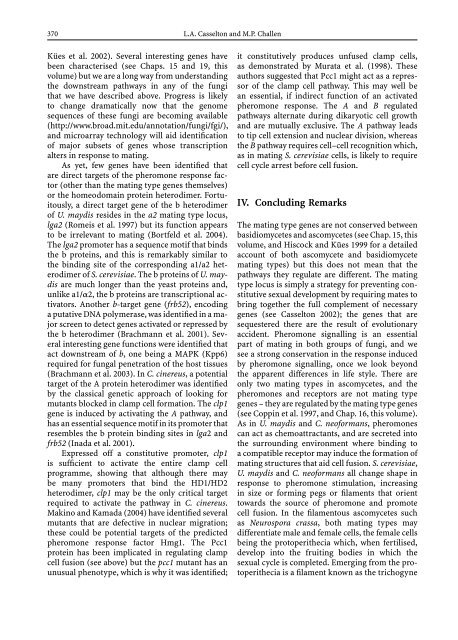Growth, Differentiation and Sexuality
Growth, Differentiation and Sexuality
Growth, Differentiation and Sexuality
You also want an ePaper? Increase the reach of your titles
YUMPU automatically turns print PDFs into web optimized ePapers that Google loves.
370 L.A. Casselton <strong>and</strong> M.P. Challen<br />
Kües et al. 2002). Several interesting genes have<br />
been characterised (see Chaps. 15 <strong>and</strong> 19, this<br />
volume) but we are a long way from underst<strong>and</strong>ing<br />
the downstream pathways in any of the fungi<br />
that we have described above. Progress is likely<br />
to change dramatically now that the genome<br />
sequences of these fungi are becoming available<br />
(http://www.broad.mit.edu/annotation/fungi/fgi/),<br />
<strong>and</strong> microarray technology will aid identification<br />
of major subsets of genes whose transcription<br />
alters in response to mating.<br />
As yet, few genes have been identified that<br />
are direct targets of the pheromone response factor<br />
(other than the mating type genes themselves)<br />
or the homeodomain protein heterodimer. Fortuitously,<br />
a direct target gene of the b heterodimer<br />
of U. maydis resides in the a2 mating type locus,<br />
lga2 (Romeis et al. 1997) but its function appears<br />
to be irrelevant to mating (Bortfeld et al. 2004).<br />
The lga2 promoter has a sequence motif that binds<br />
the b proteins, <strong>and</strong> this is remarkably similar to<br />
the binding site of the corresponding a1/a2 heterodimer<br />
of S. cerevisiae.ThebproteinsofU. maydis<br />
are much longer than the yeast proteins <strong>and</strong>,<br />
unlike a1/α2, the b proteins are transcriptional activators.<br />
Another b-target gene (frb52), encoding<br />
a putative DNA polymerase, was identified in a major<br />
screen to detect genes activated or repressed by<br />
the b heterodimer (Brachmann et al. 2001). Several<br />
interesting gene functions were identified that<br />
act downstream of b, one being a MAPK (Kpp6)<br />
required for fungal penetration of the host tissues<br />
(Brachmann et al. 2003). In C. cinereus, a potential<br />
target of the A protein heterodimer was identified<br />
by the classical genetic approach of looking for<br />
mutants blocked in clamp cell formation. The clp1<br />
gene is induced by activating the A pathway, <strong>and</strong><br />
has an essential sequence motif in its promoter that<br />
resembles the b protein binding sites in lga2 <strong>and</strong><br />
frb52 (Inada et al. 2001).<br />
Expressed off a constitutive promoter, clp1<br />
is sufficient to activate the entire clamp cell<br />
programme, showing that although there may<br />
be many promoters that bind the HD1/HD2<br />
heterodimer, clp1 may be the only critical target<br />
required to activate the pathway in C. cinereus.<br />
Makino <strong>and</strong> Kamada (2004) have identified several<br />
mutants that are defective in nuclear migration;<br />
these could be potential targets of the predicted<br />
pheromone response factor Hmg1. The Pcc1<br />
protein has been implicated in regulating clamp<br />
cell fusion (see above) but the pcc1 mutant has an<br />
unusual phenotype, which is why it was identified;<br />
it constitutively produces unfused clamp cells,<br />
as demonstrated by Murata et al. (1998). These<br />
authors suggested that Pcc1 might act as a repressor<br />
of the clamp cell pathway. This may well be<br />
an essential, if indirect function of an activated<br />
pheromone response. The A <strong>and</strong> B regulated<br />
pathways alternate during dikaryotic cell growth<br />
<strong>and</strong> are mutually exclusive. The A pathway leads<br />
to tip cell extension <strong>and</strong> nuclear division, whereas<br />
the B pathway requires cell–cell recognition which,<br />
as in mating S. cerevisiae cells, is likely to require<br />
cell cycle arrest before cell fusion.<br />
IV. Concluding Remarks<br />
The mating type genes are not conserved between<br />
basidiomycetes <strong>and</strong> ascomycetes (see Chap. 15, this<br />
volume, <strong>and</strong> Hiscock <strong>and</strong> Kües 1999 for a detailed<br />
account of both ascomycete <strong>and</strong> basidiomycete<br />
mating types) but this does not mean that the<br />
pathways they regulate are different. The mating<br />
typelocusissimplyastrategyforpreventingconstitutive<br />
sexual development by requiring mates to<br />
bring together the full complement of necessary<br />
genes (see Casselton 2002); the genes that are<br />
sequestered there are the result of evolutionary<br />
accident. Pheromone signalling is an essential<br />
part of mating in both groups of fungi, <strong>and</strong> we<br />
see a strong conservation in the response induced<br />
by pheromone signalling, once we look beyond<br />
the apparent differences in life style. There are<br />
only two mating types in ascomycetes, <strong>and</strong> the<br />
pheromones <strong>and</strong> receptors are not mating type<br />
genes – they are regulated by the mating type genes<br />
(see Coppin et al. 1997, <strong>and</strong> Chap. 16, this volume).<br />
As in U. maydis <strong>and</strong> C. neoformans, pheromones<br />
can act as chemoattractants, <strong>and</strong> are secreted into<br />
the surrounding environment where binding to<br />
a compatible receptor may induce the formation of<br />
mating structures that aid cell fusion. S. cerevisiae,<br />
U. maydis <strong>and</strong> C. neoformans all change shape in<br />
response to pheromone stimulation, increasing<br />
in size or forming pegs or filaments that orient<br />
towards the source of pheromone <strong>and</strong> promote<br />
cell fusion. In the filamentous ascomycetes such<br />
as Neurospora crassa, both mating types may<br />
differentiate male <strong>and</strong> female cells, the female cells<br />
being the protoperithecia which, when fertilised,<br />
develop into the fruiting bodies in which the<br />
sexual cycle is completed. Emerging from the protoperithecia<br />
is a filament known as the trichogyne

















